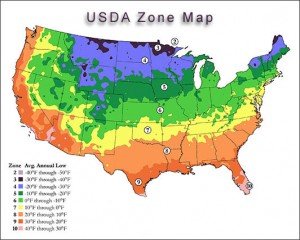On-line nursery catalogs and plant labels at garden centers list the hardiness of the trees, shrubs, vines, and perennials that they sell. Many years ago the U.S. Department of Agriculture (USDA) developed the hardiness rating scale based on geographic location from northern Canada to southern Mexico. Most U.S. gardeners live within Zones 3 to 11. Don’t know the hardiness zone where you live and garden? This information is easily found on-line by simply entering your zip code.
If a plant originates from another country, for example China, the USDA has estimated its hardiness in North America. For example, hardiness zone 6 records an average low winter temperature between 0º F – 10º F; colder zone 5 falls between -10º F to -20º F.
Minimum temperature ranges of a particular hardiness zone are just averages. In some years temps may turn out to be colder; some “hardy” plants may not survive if winter is unusually cold. Sometimes a label designates only one zone, such as Zone 4. That represents solely the cold hardiness of the species; the plant is also be winter hardy in zones 5, 6, and 7. But it may be heat tolerant in the south. It will not survive in zone 3 winters.
There are many factors that affect a plant’s ability to survive cold temperatures. Environmental factors such as soil type, sun and wind exposure, slope, proximity to buildings, and snow cover create microclimates that could influence the over-winter survival of plants. Hardiness zone ratings are guidelines; cold temperatures, microclimates and other factors can influence plant survival following an abnormally cold winter.
When ordering plants on-line, utilize hardiness zone information to determine the proper shipping date in your area. For example, a Minnesota gardener may want to delay receiving plants to mid-spring when the cold weather is subsiding; a Tennessee gardener may want delivery 2 – 3 weeks earlier.


 Posted in
Posted in 
